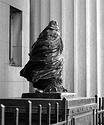1. There is no such thing as 'compensating effect' That is simply a film with overexposure latitude being given gentle development to not fully develop the overexposure. A developer like Rodinal is good for this because it is relatively inefficient at developing shadows. Giving a long, minimal agitation scheme to an grossly over exposed negative can look quite normal. It is handy to have practiced this in case you need it. It is futile to try to hit it the first time when you have made a mistake. This was handy back in the '60s because there wasn't always to carefully spot meter a night scene, filled with people who wished you harm. So you exposed film at what you thought was right, and then at what was the longest you could hold the camera. One second at f/2 was the proper exposure for more pictures than you could imagine.
2. Pushing film can mean one of two things. First, it can mean giving massive overdevelopment in order to raise the midtones to the level of highlights. You've exposed Agfa at 400. Your midtones were accidently placed as a shadow and the highlights as midtones. You've lost the shadows, but can lift what's rest.
Second, it can mean raising the grossly underexposed shadows to the normal density of shadows. That can be done one of two ways. First, using a developer whose property is to efficiently develop shadows (such as XTOL, and to a lesser degree, D-76), extend the development time to give the shadows a chance to develop. The next trick is to balance the negative, so reducing the agitation is necessary to starve the highlights. With an EI 400 film, you can usually give 2 or 3 stops underexposure and get a manageable negative, depending, of course, on the film, the scene, and your developer.
The limiting factor to exposing a film like Agfa 100 at 1600 is that you have probably underexposed the midtones below the threshold of the film. The film didn't see anything, there is nothing to develop.
Possibly gas-hypering (see astronomy) might squeeze EI 400 with some shadow detail, but it is a long shot.






